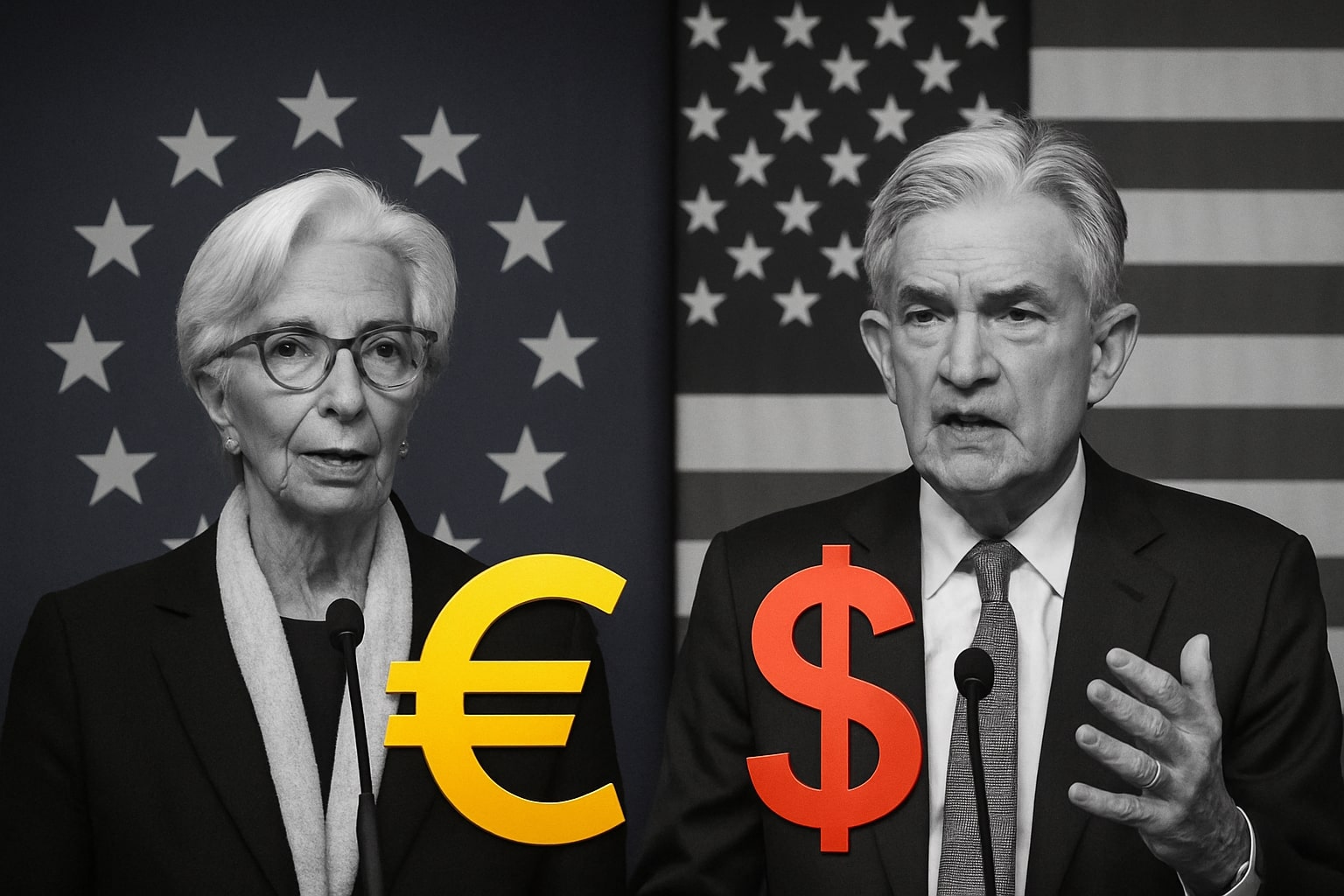
EUR/USD Price Forecast - Euro Holds 1.1600 as Fed Resistance Cuts Odds Drop to 56% and Eurozone Growth Rebounds to 1.4%
The Euro stabilizes after a weekly 0.51% rise, supported by revised GDP and stalled U.S. data releases, while the Fed’s hawkish stance and the DXY bounce from 98.99 set the stage for a breakout | That's TradingNEWs
EUR/USD Price Dislocation And Policy Divergence
The EUR/USD pair holds the 1.1600 line after a turbulent week that redefined the balance between U.S. policy uncertainty and Eurozone stability. The pair’s ability to end the week 0.51% higher, despite a 0.10% Friday pullback, reflects how aggressively markets repriced December rate-cut expectations from 70% earlier to 56% as hawkish Federal Reserve voices overwhelmed the absence of U.S. economic data during the shutdown. The U.S. Dollar Index rebounded to 99.31 after tagging 98.99, a Fibonacci pivot that halted a two-day sell-off and prevented EUR/USD from claiming a breakout above the 1.1659 50-day moving average. That failed breach kept 1.1659 as the ceiling, while 1.1600 remained the battlefield where intraday longs and shorts clashed into the weekend.
EUR/USD And The Shifting Federal Reserve Narrative
The Fed delivered one of its most divided communication weeks of the year. Jeffrey Schmid, Kashkari, Musalem, Collins, Bostic, and other regional presidents leaned toward a more restrictive stance, warning that inflation remained “too hot” and policy was “only modestly restrictive.” Schmid’s pushback was especially impactful because he dissented at the last meeting and signaled he would likely oppose any December cut without forceful evidence of deterioration. In contrast, Stephen Miran doubled down on his dovish view, emphasizing that the latest data—what little was available—should push the Fed toward easing, not away from it. Meanwhile, Powell’s carefully-neutral tone, combined with Williams’ restrained messaging, locked markets in a holding pattern. With no labor data, no CPI, and no clarity due to the shutdown’s backlog, EUR/USD reacted to rhetoric rather than fundamentals, producing intraday spikes that failed to establish follow-through beyond the 1.1659 resistance.
EUR/USD Anchored By Eurozone Stability And Revised Growth Data
The Eurozone provided a measurable counterbalance to U.S. policy turbulence. Revised Q3 GDP moving from 1.3% to 1.4% year-over-year, alongside a 0.2% quarterly gain, gave the euro just enough structural support to absorb dollar strength. Industrial production and sentiment data were mixed, but the absence of contraction allowed EUR/USD to remain resilient even as the U.S. dollar tried to rebound from deep oversold conditions. Christine Lagarde emphasized the bloc’s steady footing and reiterated vigilance without signaling policy urgency, a tone that contrasted sharply with the Fed’s contradictory messaging. The Eurozone data did not ignite a full bullish move, but it reinforced the floor above 1.1583, the 20-day moving average, and maintained 1.1500 as the deeper structural support that separates short-term noise from a real trend reversal.
Read More
-
IVE ETF Near $212: Is This S&P 500 Value Play Still Cheap for 2026?
20.12.2025 · TradingNEWS ArchiveStocks
-
XRP ETFs XRPI at $11.07 and XRPR at $15.76 Power $1.2B Inflows as XRP Fights for $2
20.12.2025 · TradingNEWS ArchiveCrypto
-
Natural Gas Price Forecast: NG=F Tests $3.60 Support as LNG Boom and $5 Henry Hub Calls Build Into 2026
20.12.2025 · TradingNEWS ArchiveCommodities
-
USD/JPY Price Forecast - Pairs Surges After BoJ’s 0.75% Hike as Pair Eyes 161.50 Resistance
20.12.2025 · TradingNEWS ArchiveForex
EUR/USD Technical Posture And Momentum Alignment
The technical map shows EUR/USD navigating a narrow channel between resistance at 1.1650–1.1665 and foundational support at 1.1600–1.1583. The RSI’s drift back into the mid-50s reflects diminishing selling pressure but not enough conviction to trigger an impulsive breakout. The pair continues to carry the imprint of lower-highs traced across previous months, reinforcing why the 1.1659 rejection mattered: it preserved the bearish macro sequence even as intraday sentiment tilted upward. A decisive break above 1.1665 would unleash a run toward 1.1720 and 1.1800, levels that coincide with prior liquidity pockets. Conversely, breaking below 1.1583 exposes 1.1500, and slipping beneath 1.1500 would mark the most meaningful bearish shift since early autumn, unlocking 1.1391, the cycle low from August.
EUR/USD Reaction To U.S. Dollar Index Stabilization
The stabilization of the U.S. Dollar Index at 98.98 after tagging multi-month lows played a crucial role in limiting EUR/USD upside. That level acted as a Fibonacci-based higher-low zone referenced by several traders, and the bounce back toward 99.40—previous support turned intraday resistance—stalled the Euro’s advance. The rebound in the 10-year Treasury yield to 4.10%, alongside real yield recovery, reinforced the dollar’s ability to defend its base despite chaotic policy signals. As long as the DXY remains above 98.98 and continues climbing toward 100.22, EUR/USD upside will remain capped, especially if the first wave of backlogged U.S. economic data comes in firm.
EUR/USD Ahead Of FOMC Minutes, NFP, PMIs, And G20 Weekend Dynamics
The next catalyst window is unusually crowded: FOMC Minutes, the G20 meeting, speeches from Williams and Kashkari, and the delayed U.S. Nonfarm Payrolls release. Markets expect clarity on whether policymakers truly believe the labor market is deteriorating or whether they intend to push back harder against easing expectations. Powell’s recent statement that the December cut is “not a foregone conclusion” adds weight to the minutes, which could reveal how deeply divided the committee is. A weak NFP print would likely propel EUR/USD toward 1.17, while strong data could drag the pair into 1.1550 testing.
EUR/USD Short-Term Bias, Structural Implications, And Market Positioning
The pair’s ability to defend the 1.1600 region despite dollar volatility signals that traders prefer accumulation on dips rather than chasing breakouts. The macro mix favors mild Euro outperformance as long as uncertainty around U.S. data persists. But the Euro’s resilience is fundamentally reactive rather than driven by intrinsic growth acceleration. The shutdown’s statistical blackout means the next significant moves will be determined by incoming numbers, not sentiment. If European data remains stable and U.S. data disappoints, EUR/USD can break into the mid-1.17s quickly. If Treasury yields continue rising and the backlog prints strong inflation or wages, EUR/USD will be driven back toward the 1.1500 threshold.
EUR/USD Final Bias And Investment Stance
Given the price structure, Eurozone stability, U.S. policy fragmentation, and the pair’s ability to hold 1.1600 despite a dollar rebound, EUR/USD is a Buy on dips above 1.1580, with upside continuation valid while 1.1600 remains intact. The stance turns neutral only if the pair breaks decisively below 1.1500, which would invalidate the current accumulation zone and reassert dollar dominance



















